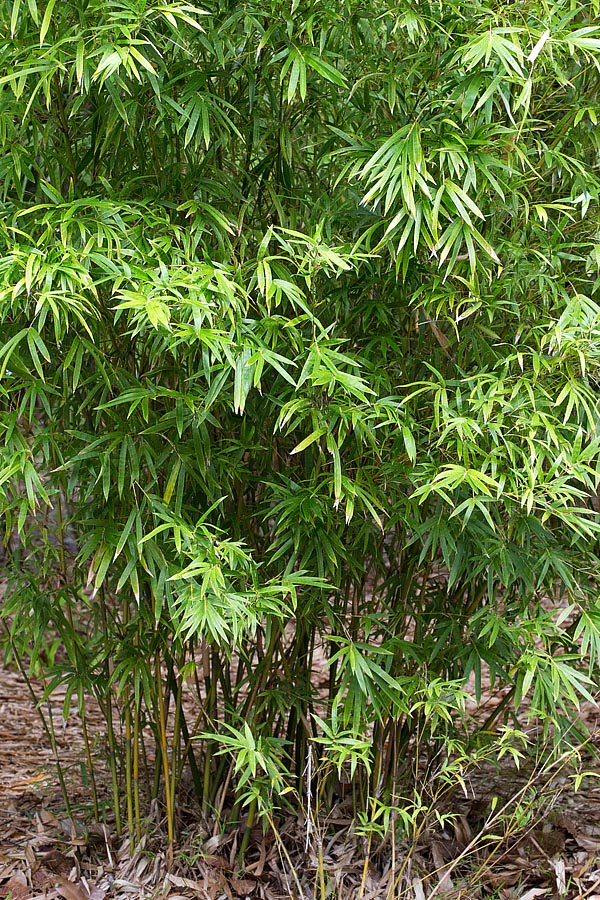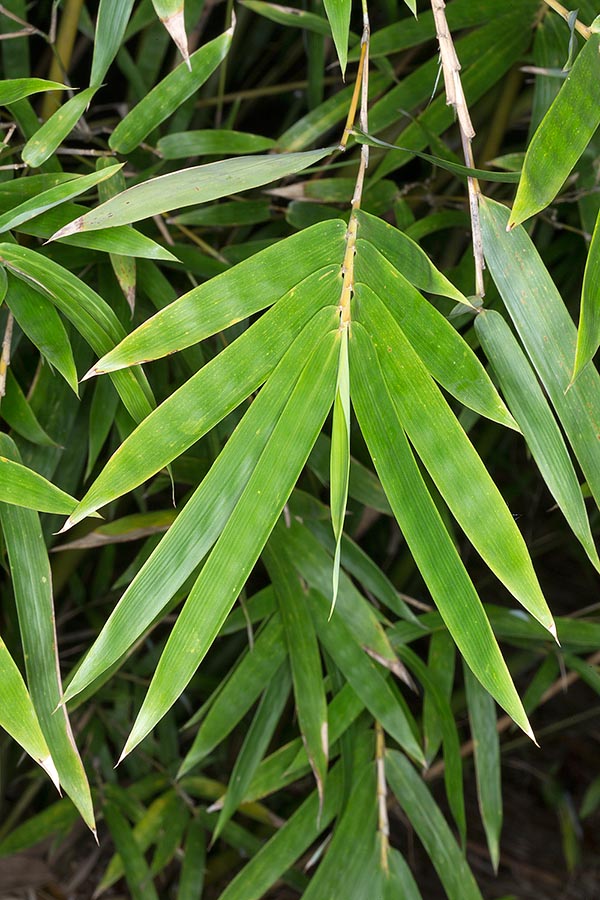Family : Poaceae

Text © Pietro Puccio

English translation by Mario Beltramini

Bambusa multiplex is native to South-East Asia where reaches the 7 m of height with 1-3 cm stems © Giuseppe Mazza
The name of the genus comes from the local Malay name “bambu”; the specific name is the Latin adjective “multiplex, plicis” = numerous, copious.
Common names: Chinese dwarf bamboo, clumping bamboo, hedge bamboo, oriental hedge (English); xiao shun zhu (Chinese); hourai-chiku (Japanese); buloh pagar (Malay); mai-liang, bambù crespo, bambù enano (Spanish); mai-phai-lieng (Thai); cay hop (Vietnamese).
The Bambusa multiplex (Lour.) Raeusch. ex Schult. (1830) is an evergreen rhizomatous perennial species, unarmed, very variable, that forms thick tufts with stems (culms) more or less erect with slightly curved apex, 0,5-7 m long and of 1-3 cm of diameter, of green colour and covered when young by a slight white pruina and by deciduous brown shaggy hairs.
The culms are hollow between the nodes, spaced of 10-50 cm, with thin walls, initially protected by trapezoidal deciduous bracts.
Ramifications grouped at the nodes, excepting the lowest ones, always more numerous upwards and almost of the same length or with the central one slightly longer, each one with 5-13 alternate leaves, lanceolate with pointed apex, 5-13 cm long and 0,8-1,5 cm broad, of intense green colour above, glaucous and slightly pubescent below.
The nodes of the floriferous flowers, devoid of leaves, bear solitary or grouped spikelets, 3-6 cm long, with 5-12 flowers, fertile in the central part.
It reproduces by seed, if available, that has a short duration of germinability, placed superficially in organic draining loam maintained constantly humid at the temperature of 24-26 °C.

Rhizomatous but not invasive adapts with several varieties even to temperate climates © G. Mazza
Usually recourse is done to the division in spring, extracting a portion of rhizome with at least 3-5 culms, to the stem cutting and to the air layering; the new plants thus obtained are to be initially put in a slightly shaded ambient with high atmospheric humidity till when well rooted. Cultivated since remote times, several varieties have been selected with more or less contained dimensions and with various colour shades and variegations of the culms and of the leaves.
Fast growing and not invasive, it is utilized particularly for borders, hedges, screens and barriers, also windbreaks, thanks to the close culms and to the dense foliage, in the tropical, subtropical and temperate climate zones; the varieties with reduced posture are ideal for small and medium-sized gardens. It resists without damages to temperatures up to about -8 °C, some degrees less may cause damages to the aerial part.
It requires full sun, for a compact posture, or slight shade, and soils rich of organic substance, draining, acidic to alkaline, maintained humid, but without stagnations that can cause dangerous rottenness; well rooted it can bear dry periods, but with a rather stunted growth. Monthly fertilizations from spring to autumn utilizing preferably a balanced product with microelements.
It well adapts to the cultivation in pot, in particular the dwarf varieties, for the decoration of indoor and luminous spaces and for bonsai.
The culms are utilized for making handicrafts and common use objects; the young buds are edible, boiled, but rarely consumed dur to their sour taste.
Synonyms: Arundo multiplex Lour. (1790); Ludolfia glaucescens Willd. (1808); Ludolphia glaucescens Willd. (1808); Arundinaria glaucescens (Willd.) P. Beauv. (1812); Bambusa multiplex (Lour.) Raeusch. (1830); Bambusa nana Roxb. (1832); Bambusa glaucescens (Willd.) Siebold ex Munr (1868); Arundarbor multiplex (Lour.) Kuntze (1891); Arundarbor nana (Roxb.) Kuntze (1891); Bambusa nana hort. ex Bean (1894); Bambusa alphonse-karrii Mitford ex Satow (1899); Bambusa glaucescens (Willd.) Merr. (1912); Bambusa nana var. alphonso-karri (Mitford ex Satow) Marliac ex E.G. Camus (1913); Bambos nana var. alphonso-karri (Mitford) Makino (1915); Bambusa glaucescens (Willd.) Holttum (1956).
→ To appreciate the biodiversity within the POACEAE family please click here.
